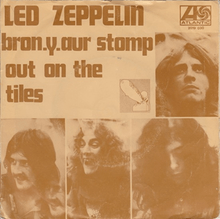Bron-Y-Aur Stomp
| "Bron-Y-Aur Stomp" | |
|---|---|
 1970 Netherlands single picture sleeve | |
| Song by Led Zeppelin from the album Led Zeppelin III | |
| Released | 5 October 1970 |
| Recorded | Headley Grange, England, 1970 |
| Genre | |
| Length | 4:17 |
| Label | Atlantic |
| Writer(s) | |
| Producer(s) | Jimmy Page |
| ISWC | T-916.457.299-0 |
"Bron-Y-Aur Stomp" is a song recorded by English rock band Led Zeppelin for their third album, Led Zeppelin III, released in 1970.
Background
The song is named after Bron-Yr-Aur, a house in Gwynedd, Wales, where the members of Led Zeppelin retreated in 1970 to write much of Led Zeppelin III after having completed a concert tour of North America.[4][5] Bron-Yr-Aur means "golden breast" or "breast of gold" in Welsh, as in a hillside of gold. Its pronunciation is [ˈbrɔn ər ˈaɪr]. The cottage had no electricity or running water, but the change of scenery provided inspiration for many of the songs on the album, including "Bron-Y-Aur Stomp."
The song's title was misspelled on the album cover; another Led Zeppelin track, "Bron-Yr-Aur", a two-minute instrumental featured on their later album Physical Graffiti, shows the correct spelling. The 2003 Led Zeppelin DVD uses "Bron Yr Aur Stomp" (without the hyphens) and How the West Was Won lists "Bron-Yr-Aur Stomp".
Composition and recording
Jimmy Page and Robert Plant wrote "Bron-Y-Aur Stomp" in 1970. It is a country music-inflected hoedown,[6] with lyrics about walking in the woods with Plant's blue-eyed Merle dog named Strider.[4] Plant reportedly named his dog after Aragorn (often called Strider) from J. R. R. Tolkien's The Lord of the Rings.[7] However, there are no explicit references to Tolkien works in "Bron-Y-Aur Stomp". The lyrics also make reference to the song "Old Shep": When you're old and your eyes are dim / There ain't no "Old Shep" gonna happen again.[8]
The group recorded the song at Headley Grange in 1970, using the Rolling Stones Mobile Studio.[9] They completed it at Island Studios in London, and Ardent Studios in Memphis, Tennessee.[9] Reflecting the rustic nature of their retreat, the song is largely acoustic. Guitarist Jimmy Page used a Martin D-28 guitar,[10] drummer John Bonham played spoons and castanets,[4] and bassist John Paul Jones played a fretless bass.[11]
Live performances
This song regularly appeared in Led Zeppelin's acoustic set from the second UK tour in 1971 to the 1973 European Tour. When the band performed the song live at Led Zeppelin concerts, John Paul Jones played an upright bass and Bonham sang harmony vocals with Plant (always stopping in the middle of the third verse). This can be seen in the footage from the Earls Court concerts in May 1975, featured on the Led Zeppelin DVD. On the band's 1977 North American tour, the song "Black Country Woman" was merged into a medley with "Bron-Y-Aur Stomp". At one Californian show (6/27/77 LA Forum), "Dancing Days" was also featured in the acoustic medley. In some shows, Page sings harmony vocals with Plant instead of Bonham (Seattle in 1977, for example).
Jennings Farm Blues
| "Jennings Farm Blues" | |
|---|---|
| Song by Led Zeppelin from the album Led Zeppelin III (Deluxe Edition) | |
| Released | 2 June 2014 |
| Recorded | 13 December 1969[9] |
| Genre | Blues rock |
| Length | 5:54 |
| Label | Atlantic |
| Writer(s) | Jimmy Page |
| Producer(s) | Jimmy Page |
| ISWC | T-914.187.369-0 |
Led Zeppelin also recorded the song as an electric blues rock instrumental, "Jennings Farm Blues" (Rough Mix of All Guitar Overdubs That Day), which later surfaced as a studio out-take on a number of Led Zeppelin bootleg recordings.[4] Jennings Farm is the name of the property on which the Plant family stayed in the early 1970s.[12] "Jennings Farm Blues" was released on 2 June 2014, as part of the remastering process of all nine albums.
Cover versions
References
- ↑ Shadwick, Keith (2005). Led Zeppelin: The Story of a Band and Their Music 1968–1980 (1st ed.). San Francisco: Backbeat Books. p. 138. ISBN 0-87930-871-0.
- ↑ Andrew Grant Jackson (20 July 2012). Still the Greatest: The Essential Songs of The Beatles' Solo Careers. Scarecrow Press. pp. 42–. ISBN 978-0-8108-8223-2.
- ↑ Stephen Davis (2005). Hammer of the Gods. Pan Macmillan. p. 119. ISBN 978-0-330-43859-9.
- 1 2 3 4 Dave Lewis (1994), The Complete Guide to the Music of Led Zeppelin, Omnibus Press, ISBN 0-7119-3528-9.
- ↑ Phil Sutcliffe, "Back to Nature", Q Magazine Special Led Zeppelin edition, 2003, p. 34.
- ↑ Led Zeppelin (25 April 2013). Led Zeppelin - III Platinum Bass Guitar: Authentic Bass TAB. Alfred Music. pp. 3–. ISBN 978-1-4706-2493-4.
- ↑ Michael D. C. Drout (2007). J.R.R. Tolkien Encyclopedia: Scholarship and Critical Assessment. Taylor & Francis. pp. 540–. ISBN 978-0-415-96942-0.
- ↑ Jean-Pierre Hombach. Elvis Presley The King of Rock ’n’ Roll. Lulu.com. pp. 87–. ISBN 978-1-4716-2862-7.
- 1 2 3 Dave Lewis (2012). Led Zeppelin: From a Whisper to a Scream; The Complete Guide to the Music of Led Zeppelin. Omnibus Press. p. 38. ISBN 978-1-78038-547-1.
- ↑ Tolinski, Brad (2012). Light and Shade: Conversations with Jimmy Page. New York City: Crown Publishers. eBook. ISBN 978-0307985736.
- ↑ Akkerman, Gregg (2014). Experiencing Led Zeppelin: A Listener's Companion. Lanham, Maryland: Rowman & Littlefield. p. 37. ISBN 978-0-8108-8916-3.
- ↑ Dave Thompson (2014). Robert Plant: The Voice That Sailed the Zeppelin. Backbeat Books. pp. 94–. ISBN 978-1-61713-614-6.